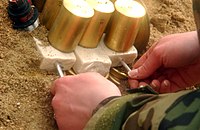Plastic explosive: Difference between revisions
m Date maintenance tags and general fixes |
not obsolete |
||
| Line 2: | Line 2: | ||
[[Image:Eod2.jpg|200px|thumb|A [[C-4 (explosive)|C-4]] plastic explosive.]] |
[[Image:Eod2.jpg|200px|thumb|A [[C-4 (explosive)|C-4]] plastic explosive.]] |
||
{{redirect|Plastique}} |
{{redirect|Plastique}} |
||
'''Plastic explosive''' (or |
'''Plastic explosive''' (or '''plastique''') is a specialised form of [[explosive material]]. It is soft and hand malleable and may have the added benefit of being usable over a wider temperature range than pure explosive. Common plastic explosives include [[Semtex]] and [[C-4 (explosive)|C-4]]. Plastic explosives are especially suited for explosive [[demolition]] as they can be easily formed into the best shapes for cutting structural members, and have a high enough [[velocity of detonation]] and [[density]] for metal cutting work. They are generally not used for ordinary [[blasting]] as they tend to be significantly more expensive than other materials that perform just as well in that field. Also, when an explosive is combined with a [[plasticizer]], its power is generally lower than when it is pure. |
||
== History == |
== History == |
||
Revision as of 18:39, 10 December 2008
This article needs additional citations for verification. (July 2007) |

Plastic explosive (or plastique) is a specialised form of explosive material. It is soft and hand malleable and may have the added benefit of being usable over a wider temperature range than pure explosive. Common plastic explosives include Semtex and C-4. Plastic explosives are especially suited for explosive demolition as they can be easily formed into the best shapes for cutting structural members, and have a high enough velocity of detonation and density for metal cutting work. They are generally not used for ordinary blasting as they tend to be significantly more expensive than other materials that perform just as well in that field. Also, when an explosive is combined with a plasticizer, its power is generally lower than when it is pure.
History
The first plastic explosive was Gelignite, invented by Alfred Nobel in 1875.
One of the simplest plastic explosives was Nobel’s Explosive No. 808, also known as Nobel 808 (often just called Explosive 808 in the British Armed Forces during the Second World War), developed by the British company Nobel Chemicals Ltd well before World War II. It had the appearance of green plasticine with a distinctive smell of almonds. During World War II it was extensively used by the British Special Operations Executive (SOE) for sabotage missions. It is also the explosive used in HESH anti-tank shells.
During and just after World War II a number of new RDX-based explosives were developed, including Compositions C, C2, and eventually C3. Together with RDX these incorporate various plasticisers to decrease sensitivity and make the composition plastic.
The origin of the obsolete term plastique dates back to the Nobel 808 explosive introduced to the US by the British in 1940. The samples of explosive brought to the USA by the Tizard Mission had already been packaged by the SOE ready for dropping to the French Resistance and were therefore labelled in French, as Explosif Plastique. It is still referred to by this name in France, and also by a few Americans. However, most English-speaking users refer to it either by the actual label printed on the packaging (e.g. C-4 or Semtex) or as plastic explosive.
C3 was effective but proved to be too brittle in cold weather. In the 1960s it was replaced by C-4, also using RDX but with polyisobutylene and di(2-ethylhexyl)sebacate as the binder and plasticizer.
Semtex was also developed in the 1960s by Stanislav Brebera by mixing of RDX with PETN and then adding binders and stabilizers.
List of plastic explosives
- Austria: KNAUERIT
- Czech Republic: Semtex
- Finland: PENO
- France: PE4, PLASTRITE (FORMEX P 1)
- Germany: Sprengkörper DM12, (Sprengmasse, formbar)
- Greece: C3, C4
- Italy: T-4 Plastico
- Poland: PWM, NITROLIT
- Russia: PW-5A Plastic Explosive
- Slovakia: CHEMEX (C4), TVAREX 4A
- Sweden: Sprängdeg m/46
- Switzerland: PLASTITE produced by SSE
- USA: C-4 (Composition C-4), Detasheet, Primasheet, Multiple PBX's (Plastic Bonded Explosives)
- United Kingdom: PE4, DEMEX
- Yugoslavia/Serbia: PP–01 (C4)
Usage
This section needs additional citations for verification. (April 2007) |
Plastic explosive is commonly used by engineers and combat engineers. The most common commercial use of plastic explosives is for hardening high manganese percentage steel.[1] This material is typically used for train rail components and earth digging implements.
Some terrorist groups have also used plastic explosives, especially Semtex and C-4. In October 2000, terrorists used C-4 to attack the U.S.S. Cole, killing 17 sailors[2] In 1996, terrorists used C-4 to blow up the Khobar Towers U.S. military housing complex in Saudi Arabia.
References
- ^ Explosive Hardening, PA&E, Inc.
- ^ Brother of USS Cole Victim Speaks Out, Democracy Now!
